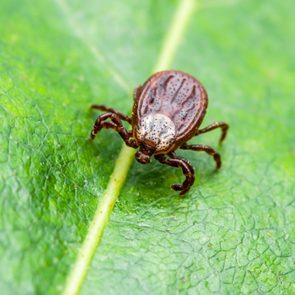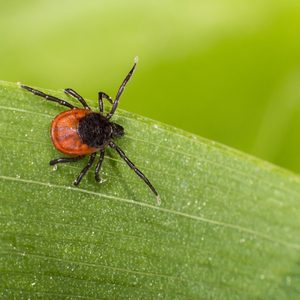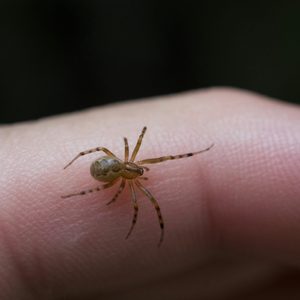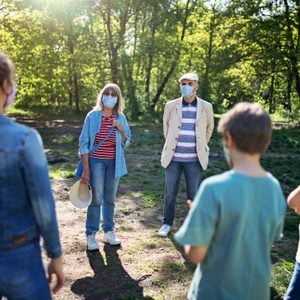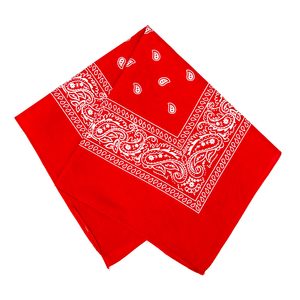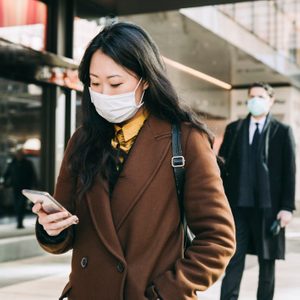An innocent walk through the woods with your pup can result in ticks entering your home. While many varieties of ticks aren’t prone to making a home indoors. Deer ticks, for example, typically die within 24 hours, and can only survive short periods in places where moisture content is less than around 90 per cent. Brown dog ticks, however, can make their nests and thrive indoors. So, if you find a tick in your house, be sure to keep these things in mind. (Take a look at the most disgusting bugs in your home—and how to get rid of them.)
Check yourself and your family
A long walk in the woods with Fido and the family on a beautiful day can result in ticks hitchhiking their way into your home via your clothing and the dog’s fur. Be sure everyone wears clothing that covers their skin. Also, be sure to carefully check your hair and your pet’s fur. Comb through your dog’s fur, and check for any bumps. Also, check your pet’s feet (including between the toes), inside their ears, and around the face and neck, according to the American Kennel Club. Have an outdoor cat? You’ll want to check them every time they come in. (Here are some common myths about ticks.)
Use tick treatments
For an extra dose of safety, be sure to prevent ticks from clinging to your animals in the first place by using tick prevention. Your vet can recommend systemic treatment in the form of monthly chewable tablets, or tick collars, sprays, and spot-on treatments
Modify your landscape
To keep ticks out of your home, keep them out of your yard. Consumer Reports suggests keeping your lawn mowed to a height of eight centimetres [three inches], getting rid of brush, weeds, and other debris, raking up leaf litter and cutting down underbrush for several feet into any woods that border your yard. You may also want to use wood chips or gravel to create a barrier between wooded areas where ticks are common and your lawn and moving woodpiles, bird feeders, and birdbaths far from your home to keep mice and chipmunks, which are hosts for ticks, away.
Repair and seal any crevices or gaps
Most ticks have no interest in coming indoors. However, brown dog ticks can be enticed indoors through small cracks and crevices that you can’t even see. If this happens and ticks start laying eggs, you could have a full-blown infestation on your hands. So, this is one more reason to be diligent with your efforts to seal up cracks and openings in your home’s exterior.
Vacuum like you mean it!
Suck up any ticks in your home with a vacuum, suggests the Environmental Protection Agency (EPA). The device will not only pick up the ones you see but will gather ticks in all life stages. Use it especially in places frequented by your outdoor animals, as well as your carpets, rugs, and furniture.
Scatter diatomaceous earth
You can scatter powders called desiccants in your home. Pests brush up against them and the powders destroy the insects’ waxy outer layers. The two most common desiccants are diatomaceous earth and boric acid. Boric acid can be toxic if ingested, so diatomaceous earth is a safer alternative. Rake diatomaceous earth into the carpet, and into the corners of any uncarpeted floors. Remove after a week. It’s made up of tiny fossilized aquatic organisms that pierce the tick’s outer layer as it crawls over the fine powder, dehydrating the tick without using toxic pesticides.
Dry clothes, then wash them
When coming indoors after spending time outside, immediately take off your clothes and throw them in the dryer. This will kill any ticks that are on the clothes. Leave the clothes in the dryer on high for 15 minutes, and then wash them.
Next, find out the best way to remove a tick.

Princess Diana’s last words
The horrifying car accident that killed Princess Diana in 1997 shook not only her country, but the world. As conspiracy theories swirled about what caused the crash, eyewitnesses came forward to share their stories. The final words they heard from the princess emphasize how tragic that fateful night was.
In one of the first detailed accounts in the wake of the accident, French doctor Frederic Mailliez told the Times of London that he’d started treating Princess Diana, not realizing at the time that he was in the presence of royalty. As Diana struggled to breathe, she let out cries of pain and kept repeating how much she hurt until losing consciousness, Dr. Mailliez said. Other reports at the time specifically claimed she’d shouted, “Oh my God, leave me alone.” (These 10 myths about the royal family, however, are absolutely false.)
Even today, new stories are still emerging. On the 20th anniversary of Princess Diana’s death in 2017, French firefighter Xavier Gourmelon told The Sun that his team was the first to arrive at the site of the crash. He stayed by her while she was taken out of the Mercedes, not recognizing the princess either. Before rescuers helped her out of the car, Gourmelon claimed he heard Diana say, “My God, what’s happened?” before going into cardiac arrest. Gourmelon said he gave her CPR and that she seemed stable when she left in the ambulance, but he’d kept his experience a secret (except when giving evidence in Diana’s inquest in 2007) until leaving the fire department because French firefighters aren’t allowed to talk to the media.
Decades later, Princess Diana’s legacy continues as we learn even more about her, like these secrets about Princess Diana that no one knew about until after her death.

The late Princess Diana was renowned for her profound effect on the fashion world, but her most iconic hairstyle, immortalized during her 1990 British Vogue photo shoot, almost never came to be.
Sam McKnight served as the hairstylist for the aforementioned shoot and made the changes to Diana’s locks firsthand. In his new book, Hair by Sam McKnight, he explained the bit of follicle-manipulating magic that made Diana first take a liking to the style. (These nine secrets about Princess Diana were only revealed after she died.)
“I made her hair look short in the tiara for the shoot and she decided she liked it…As she was leaving, Diana asked what would I do to her hair if I had free reign…I suggested cutting it short and she, to my surprise, agreed, and we did it there and then.”
After the spontaneous quick snip, McKnight formed a working relationship with Diana. Whenever she was in London, he would swing by for a morning hair maintenance appointment and would sometimes swing by in the evening if the Princess had an event in the evening. (This is what really happened between Diana and Prince Charles.)
But it wasn’t just Diana who took a liking to McKnight’s stylings; William was a pretty big fan, too. “Sometimes her beloved boys would be there and I would cut their hair, too,” he writes. “I remember Prince William responded in glee when I put gel in his hair for the first time.” Yep, a haircut that shaped a decade of style was done without an appointment.
[Source: People]
Next, find out the story behind Princess Diana’s revenge dress.

The potential benefits of apple cider vinegar
Apple cider vinegar (ACV) is a natural product made from apples that are crushed and fermented, which creates a host of bacteria (the good kind!). The result is a vinegar, rich in acetic acid compounds, long used as a folk remedy for a variety of health benefits. While you can enjoy potential benefits just by cooking with apple cider vinegar, you can also try an apple cider vinegar drink recipe—with some caveats.
While apple cider vinegar has been a folk remedy for a long time, scientists are still researching its benefits. They may help with:
- High blood sugar
- Weight loss
- Digestion
- Immunity
- High blood pressure
- Sore throat or congestion
- Stopping infection
- Increasing energy
Can I drink apple cider vinegar every day?
Many proponents of ACV advise taking 1-2 tablespoons daily, whether in a drink or with food. As with any remedy, you should check with your doctor first, especially if you’re pregnant.
When’s the best time to drink apple cider vinegar?
Sip your apple cider vinegar drink first thing in the morning or right before a meal. Taken before a meal, the vinegar drink can help you feel full faster, which can aid in weight loss.
Should I take a shot of apple cider vinegar?
No! Taking a shot of vinegar alone is an acidic blast that can harm the enamel of your teeth and even damage your esophagus and lungs. The key is to dilute the vinegar in water.
How to make an apple cider vinegar drink:
The ratio:
- 1 tablespoon apple cider vinegar
- 8 ounces water
Even diluted, the vinegar drink may not taste fabulous, so you can add a squeeze of honey and/or a dash of cinnamon or ginger.
Sip the drink slowly. If you’re drinking ACV daily, you may want to drink through a straw to prevent wearing the enamel of your teeth.
These are the things you should never do while taking apple cider vinegar.
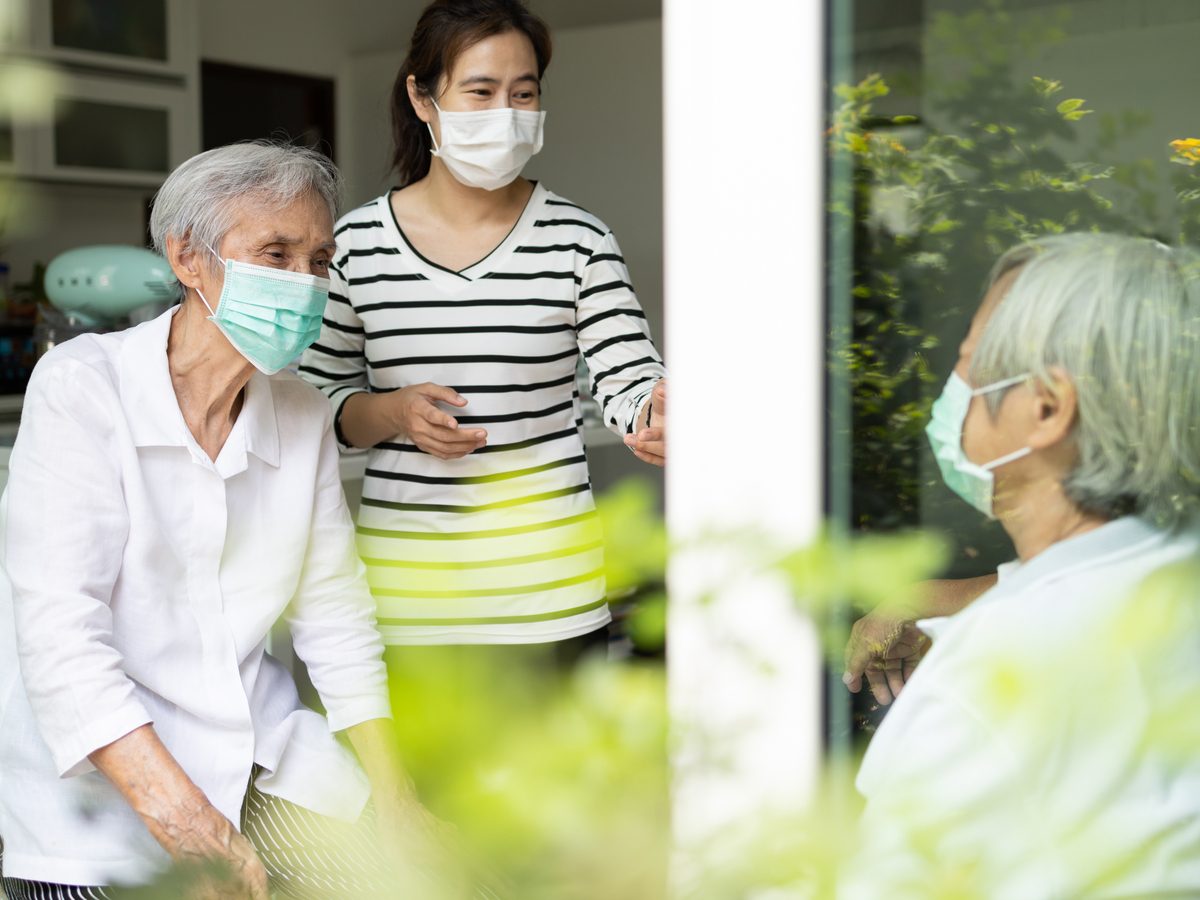
Reader’s Digest Canada: Most Canadians seem to agree wearing a mask in public is one of the best things we can do to prevent the spread of COVID-19. What’s the science backing that up?
Dr. Amy Tan: In the last couple of months, a body of new scientific evidence has shown that if 80% of the population wears a reusable cloth mask, the spread of COVID-19 in the community decreases by 40%. That kind of decrease is enough to drive down the number of people an infected person will spread the virus to, so the number of cases isn’t growing exponentially. That’s extremely significant. It’s why we need a high level of public buy-in in order for masks to work.
Because my mask protects you and your mask protects me?
Exactly. We didn’t realize that in the early stages of COVID when we were still looking at masks in terms of their potential to protect the wearer, but now we know that the chief purpose of wearing a mask is not to keep the coronavirus out, but to keep your own droplets in. Based on what we know now, the virus survives and spreads via droplets of saliva that are released when we sneeze or cough, but also when we sing, cheer, laugh, or talk closely. Another early misconception was that that only people with symptoms could spread the virus. That’s how it was with SARS and MERS, but now we know that with COVID-19 you can absolutely be infected and have no idea. That means everyone needs to conduct themselves as if they were a carrier. (Here’s advice on how to handle social distancing rule breakers.)
What should I be looking for in an ideal mask?
You want something that is made from natural fibres so that it’s breathable. A mask made of tight weave, high thread count cotton is good. The more layers the better—balanced, of course, with breathability. The WHO recommends three layers of tight weave cotton or two layers with a coffee filter or a dried baby-wipe in between. Anything less than that is going to be incrementally less effective.
But I would also say don’t get too hung up on the best mask. This is not about perfection; it’s about decreased risk. One of the things we have learned more recently is that transmission has a lot to do with viral load—essentially the amount of the virus with which a person comes into contact. So if I produce 100 droplets and my mask contains 80, then your risk—both of getting the virus and how severe a case—is a lot less significant. Wearing a bandana is definitely better than wearing nothing.
What can you tell us about proper mask cleaning protocol?
You want to wash your mask daily at the end of the day. Some people sterilize them, which is fine but not necessary. A washing machine is ideal but you can also just use soap and water, in the same way that you would wash your hands. Always wash your hands before you touch your mask, and only touch it by the loops. (Find out more diseases you can prevent simply by washing your hands.)
If mask wearing is about containing droplets, why is washing every day necessary? Presumably, I don’t need to be protected from my own droplets.
That’s true, but there are a few reasons. If an infected person was talking to you and some of their droplets got on your mask, you wouldn’t want to get infected that way. We don’t know how long COVID-19 can survive on surfaces, but definitely it’s better to be safe and be as hygienic as possible.
So then wearing a mask might also keep other people’s droplets out?
I know, it’s confusing. And part of that is because the science is constantly evolving. That’s not a bad thing. That’s how scientific discovery works. We know that the main reason we wear masks is to contain our own droplets, but there is some evidence to suggest that mask wearing can decrease your chances of exposure.
For those of us whose laundry hampers have been full since spring, are disposable masks a good option?
The white and blue disposable masks that you see a lot of people wearing are effective in terms of capturing droplets. We recommend reusable cotton because it’s better for the environment and it’s a lot more cost-effective than having to constantly replenish your supply.
What about face shields—the clear full face visors that you see on a lot of service industry workers. Are those more safe? Less safe?
We don’t have head-to-head or directly comparative studies, but there is anecdotal evidence that looks at restaurant employees who wore masks vs. those who wore shields and it’s the employees who wore shields who got infected. The shields that I’ve seen aren’t sealed at the bottom, so it’s possible that is the issue. What shields do provide though is eye protection, which is a powerful entry point. So if you wanted to be as protected as possible, that might be face shield and face mask.
How important is it that your mask covers your nose?
Very important. Droplets can come from your nose as well as your mouth. My big tip is to look for a mask that fits your nose—tight without being uncomfortable—so that you don’t have to worry about it falling down all the time. I really like a bendable adjustable nosepiece which really help with slippage, but everyone has different preferences. People think it’s a one-size-fits-all and they try one mask and it’s uncomfortable and they just give up, but that’s not how it works. If you wear glasses, you understand. It’s not like most of us buy the first pair of glasses we try on. It takes a little time to find the pair that works on your face; you may have to make some adjustments.
What about the masks with the little valves on the side?
Don’t use those ones. That’s an exit valve to help you breathe more easily, but it’s also how your droplets can escape. Those masks are intended for industrial use, and to protect you from things like drywall dust.
And the ones intended for front line workers. Should regular folk be sporting those masks?
Please don’t. Those masks are intended for medical professionals. The other thing is that if you work in a profession that requires medical-grade PPE, you get fitted every year or so. If the mask isn’t fitted to your face, the seal isn’t effective, so there’s not much of a point. (Here are 11 more face mask mistakes you should avoid.)
I’ve heard of people wearing masks in their own homes. Is that a little over the top?
If a person is sick in a house or in a house with multigenerational families there might be some benefit. With outbreaks we tell people to self-isolate and to not share a bathroom, but not everyone has that option. In cases where you are at greater risk, a mask offers an extra layer of protection. If you are in a secure bubble, you probably don’t need to wear a mask in your home. But if you invite guests inside your home who aren’t in your bubble then you should definitely all wear masks. I wouldn’t recommend seeing people outside of your bubble in your home or in any indoor space, but if you are going to do that, a mask is risk mitigation.
Masks during sex: Yay or nay?
If your partner is in your bubble it’s not necessary, but if it’s something more casual, not somebody you’re living with, then definitely. As far as we know, COVID-19 is not an STD, so it’s kissing and any other saliva exposure that is the high risk behaviour.
When we are on the other side of this pandemic (knock on wood!), will mask wearing become more of a normal day to day activity in North America the way it is in many Asian cities?
I don’t know if it will be something that is embraced by the entire population—maybe during flu season—but what I do hope is that it becomes a normalized reaction when, and if, we encounter another SARS or COVID-19, which I really hope is not any time soon. In Hong Kong, they started masking as soon as they saw what was happening in Wuhan. And even in Richmond, B.C., which is my hometown and which has a large population of Asian Canadians, there was a lot less resistance. I think if we hadn’t been arguing about whether masks are helpful in May and early June, that would have made a significant difference. I hope we will learn from this uphill battle.
Are you surprised there is still a small but vocal minority who are anti-mask from a civil liberties perspective?
I think from a civil liberties perspective, wearing a mask is a ticket to your freedom. If you wear one you can hang out with the people you want to hang out with, you can go to many of the places you want to visit. Wearing a mask is a very small ask and it’s not as if we aren’t used to abiding by laws that protect our safety. We all wear seatbelts.
What is the most ridiculous fake news you have heard from the anti-mask camp?
Probably that they cause restricted oxygen flow. That’s not true. If it were, health care professionals like myself would be passing out while we do our jobs on a daily basis.
Check out more eye-opening facts that will convince you to wear a face mask.
